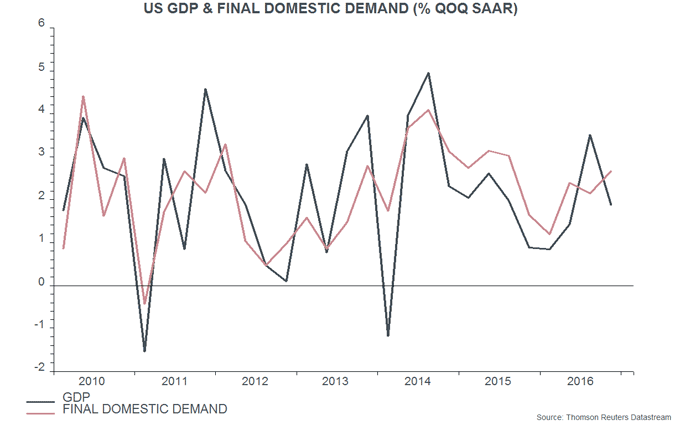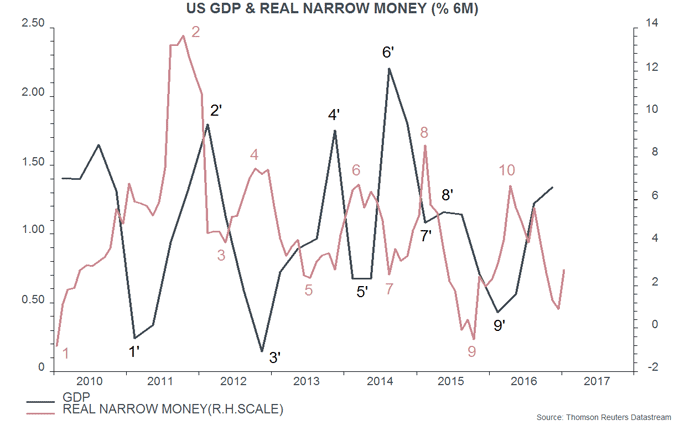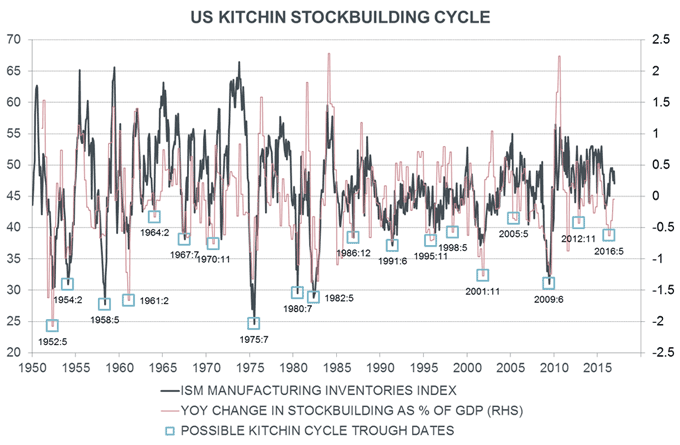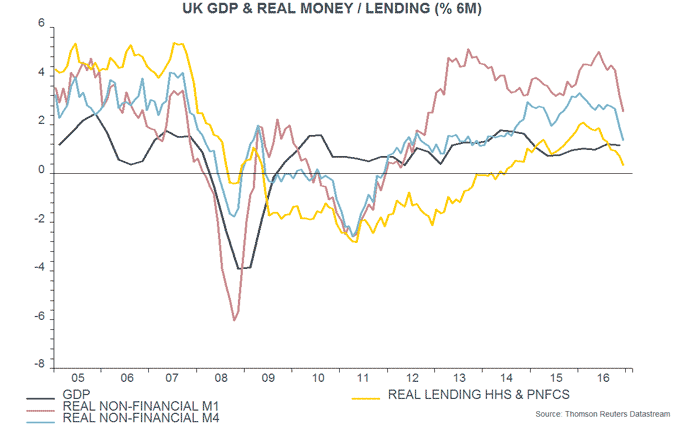Entries from January 29, 2017 - February 4, 2017
Has the UK's MPC shifted to an unemployment target?
The MPC revised up its growth forecast significantly while making little change to its inflation forecast and retaining a neutral policy stance – contrary to the expectation here of a shift to a tightening bias.
How was the MPC able to raise forecast GDP growth over 2017-2019 by 0.8 percentage points without lifting its longer-term inflation numbers? Mainly by raising its estimate of labour market slack: the “equilibrium” unemployment rate is now judged to be 4.5%, down from 5% in November. The MPC claims that lower-than-expected wage growth over 2014-16 warrants this change of view. Recent wage news, however, has surprised to the upside – annual earnings growth is estimated to have been 2.75% in the fourth quarter of 2016, up from a projected 2.5% in November. Why is the MPC changing its assessment now, rather than three months ago, or earlier?
Based on the forecasts, a fair description is that the MPC is now pursuing a policy of unemployment- rather than inflation-targeting. The unemployment rate is projected to be stable at or below 5.0% through 2019, while inflation remains above 2.5% until mid-2019, returning to the 2% target only in 2020. The MPC evidently regards sustained above-target inflation as a “price worth paying” to prevent a temporary rise in unemployment from its current level.
While the policy statement indicates that rates could move in either direction, there is a hint of hawkish dissent in the minutes, according to which all members agreed that “there were limits to the degree to which above-target inflation could be tolerated”, while, for some, “the risks around the trade-off embodied in the central projection meant they had moved a little closer to those limits”.
Governor Carney has held the line for now but may have to yield ground by May if – as expected here – the economy continues to grow respectably in early 2017 while inflation and wage growth rise by more than the MPC forecasts.
US money trends suggesting mid-year "soft patch"
The US economy picked up speed in the second half of 2016 and has started 2017 strongly. This acceleration was predicted by monetary trends, which now suggest a slowdown over the spring and summer. The slowdown may be modest and temporary, partly reflecting the current positive status of the Kitchin stockbuilding and Juglar business investment cycles. It may, however, constrain the Federal Reserve’s rate-hiking plans.
GDP growth fell to 1.9% annualised in the fourth quarter of 2016 from 3.5% in the third, reflecting a normalisation of agricultural exports after a temporary surge. Growth of final domestic sales strengthened between the two quarters, from 2.1% to 2.7% – see first chart.

The two-quarter rise in GDP in the fourth quarter was the strongest since the fourth quarter of 2014. As previously discussed, swings in six-month real narrow money expansion have consistently led fluctuations in two-quarter GDP growth in recent years – second chart. GDP acceleration in late 2016 had been predicted by stronger real narrow money growth in late 2015 / early 2016.

The Federal Reserve last week revised its historical money stock data to incorporate updated seasonal adjustments. According to the revised figures, six-month real narrow money growth peaked in April 2016 – four months earlier than previously reported. Allowing for an average nine-month lead from money to activity, with a normal range of six to 12 months, this suggests that two-quarter GDP growth will peak in the first quarter of 2017, plus or minus one quarter.
Real money growth held up through August 2016 but then fell sharply into December, suggesting an economic slowdown from late spring through September 2017.
Could the economy be seriously weak later in 2017? This is not the central scenario here, for two reasons. First, real money growth appears to have staged a partial recovery in January, based on weekly data through mid-month – the last data point on the second chart is a January estimate.
Secondly, serious economic weakness during the second half would be at odds with the assessment here that the Kitchin stockbuilding and Juglar business investment cycles will remain in upswings throughout 2017.
The Kitchin cycle, usually described as being of between three and five years’ duration, is judged here to have bottomed in mid-2016. The third chart shows an attempt to identify troughs in this cycle over the last 65+ years using two indicators – the Institute for Supply Management manufacturing inventories index and the contribution of stockbuilding to the annual change in GDP. The latter series reached a level consistent with a trough in mid-2016. This date would also fit with the suggested timing of the previous trough in late 2012 – the average interval between troughs over the whole period shown in the chart has been three years and seven months.

Kitchin cycle upswings usually last for at least 18 months. A mid-2016 trough would imply that the cycle will continue to provide a tailwind to the economy through end-2017.
As an aside, the strength of stock and commodity prices since mid-2016 is consistent with the Kitchin cycle having moved into an upswing. Based on the dates in the chart, the S&P 500 index rose on average by 14.7% percentage points (pp) more in the 18 months following a Kitchin cycle trough than in the prior 18 months. The Journal of Commerce industrial commodity price index rose on average by 20.2 pp more in the post- than pre-trough 18 months.
The Juglar business investment cycle is usually of seven to 11 years’ duration and last bottomed in 2009, implying that another trough is due by 2020. The upswing, however, was interrupted in 2014-15 by the collapse in energy prices and associated profits weakness. With this drag now reversing, a late burst of strength is possible in 2017-18 before the cycle moves into another low.
UK money trends turning cautionary
Strong UK monetary expansion before and after the June EU referendum signalled that economic growth would remain solid in late 2016 / early 2017. December money numbers released today were better than November’s but trends have clearly weakened, particularly in real terms, suggesting an economic slowdown during the second half of 2017.
Some economists of a monetarist persuasion may cite still-solid annual growth of the Bank of England’s broad money measure, M4ex, as a reason for optimism about economic prospects. M4ex growth rebounded from 6.7% in November to 7.2% in December – not far below September’s peak of 7.7%.
The annual M4ex increase, however, continues to be inflated by a significant rise in money holdings of fund managers and other financial institutions earlier in 2016 – such holdings are of limited relevance for assessing near-term spending prospects. The preferred broad money measure here is non-financial M4, comprising holdings of the household sector and private non-financial corporations (PNFCs). This measure rose an annual 5.8% in December.
Annual growth rates, moreover, are slow to reflect changes in trend. The six-month increase in non-financial M4 eased to 5.2% at an annualised rate in December; three-month growth was just 3.0%. The narrow non-financial M1 measure also slowed significantly in late 2016 – see first chart.
Monthly growth of non-financial M4 recovered from 0.1% to a modest 0.3% in December. Non-financial M1 had been unchanged in November and rose 0.5% last month.
Economic prospects are related to real rather than nominal monetary trends. With consumer price momentum rising sharply at end-2016, six-month growth of real non-financial M1 fell to its lowest level since December 2012; real non-financial M4 growth was the lowest since January 2014 – second chart.
The six-month real growth rates remained solid until October 2016, suggesting respectable GDP expansion during the first half of 2017, allowing for an average nine-month lead from money to activity. Together with a positive carry-over effect from late 2016 strength, this could allow annual average GDP growth in 2017 to reach 2% even incorporating a second-half slowdown.
Household and corporate (PNFC) money trends are informative about prospects for consumer spending and business investment respectively. Six-month growth rates of real household and PNFC M1 were similar in December but household expansion has fallen significantly since October; slower GDP growth may reflect, at least initially, fading consumption strength rather than weaker investment – third chart.

